'IT' 카테고리의 다른 글
| 스마트폰 현미경 1000배율 (PC사용가능) 최대할인쿠폰코드 (0) | 2019.12.24 |
|---|---|
| 삼성 아카데미 할인쿠폰 5%~7% (0) | 2019.12.23 |
| 라스트킹스(LastKings) (원스토어) (0) | 2019.12.21 |
| 윈도우 엑셀파일, 맥북엑셀에서 안열릴때 (0) | 2019.12.12 |
| 초보자를 위한 파워포인트 초간단 단축키 (0) | 2019.12.11 |
| 스마트폰 현미경 1000배율 (PC사용가능) 최대할인쿠폰코드 (0) | 2019.12.24 |
|---|---|
| 삼성 아카데미 할인쿠폰 5%~7% (0) | 2019.12.23 |
| 라스트킹스(LastKings) (원스토어) (0) | 2019.12.21 |
| 윈도우 엑셀파일, 맥북엑셀에서 안열릴때 (0) | 2019.12.12 |
| 초보자를 위한 파워포인트 초간단 단축키 (0) | 2019.12.11 |
영웅들과 함께 하는 왕좌를 향한 모험이 시작 된다!
appfing.com
아름다운 그래픽의 언리얼 엔진으로 탄생된 ‘라스트킹스'에서는 강력하고 화려한 스킬들을 가진 영웅들과 세력의 문화별로 탄생된 영지를 자신의 입맛대로 건설 하실 수 있습니다.
아우룸의 힘을 얻어 무너진 세계를 통치하고 강력한 힘을 자랑하는 길드를 만들어 전 세계의 친구들과 함께 세력을 구축하세요.
다양한 전략과 전술이 필요한 군단 전투를 통해 적을 처단하고, 자신의 영지와 친구들을 지키기 위한 여정을 지금 바로 시작하세요!
★ 극강 스케일의 전략 전투!
다양한 군단 병력을 통해 나만의 최강 군단을 만들어 보세요.
강력한 스킬을 가진 영웅들과 군단들의 상성을 통해 전장에서의 승리를 쟁취해 나가세요
★ 눈이 즐거운 화려한 연출!
얼리얼 엔진을 통해 만들어진 시네마틱으로 영지의 사건들을 확인하세요
화려한 그래픽의 영웅들과 악당들의 이야기가 지금 펼쳐집니다
★ 입맛대로 성장해 나가는 나만의 영지!
영지의 악당들을 몰아내어 위험에 빠진 영지를 구원해 주세요.
자신만의 영역을 넓혀 영지를 농업의 도시로 혹은 군사 기지로 가꾸어 보세요.
★ 다양한 영웅들의 성장!
다양한 영웅들과 함께 전투를 준비 하세요.
영웅들의 성장을 통해 던전과 군단전의 전투에서 승리를 쟁취 하세요.
★ 전 세계의 친구들과 함께하는 길드!
전 세계의 친구들과 하나가 되어 최강의 길드를 만들어 보세요.
길드간의 투쟁을 통해 월드의 패권을 손에 쥐어 보세요. 오늘의 제왕은 바로 당신 입니다
| 삼성 아카데미 할인쿠폰 5%~7% (0) | 2019.12.23 |
|---|---|
| 다음팟인코더 공유 (0) | 2019.12.21 |
| 윈도우 엑셀파일, 맥북엑셀에서 안열릴때 (0) | 2019.12.12 |
| 초보자를 위한 파워포인트 초간단 단축키 (0) | 2019.12.11 |
| Docker? 도커? 기능 간단하게 3가지 (0) | 2019.12.06 |
오늘 있었던 일이에요.
맥북에서 특정 엑셀 파일이 열리지를 않더라구요.
그래서 확인해 봤더니 윈도우에서 엑셀파일을 만들때
함수나 수식이 들어갔을 경우 안열리는 경우가 있다고
하더라구요.
그래서 윈도우에서 작성한 엑셀 파일을 맥북에서 볼수 있게
하려면 값복사를 통해서 저장한 다음 전달해줘야
맥북에서 문제 없이 볼 수 있어요.
간단한 해결방법이지만 혹시 모르시는 분들을 위해
영상으로 남겨 봤어요.
| 다음팟인코더 공유 (0) | 2019.12.21 |
|---|---|
| 라스트킹스(LastKings) (원스토어) (0) | 2019.12.21 |
| 초보자를 위한 파워포인트 초간단 단축키 (0) | 2019.12.11 |
| Docker? 도커? 기능 간단하게 3가지 (0) | 2019.12.06 |
| 도커가 뭔지 알아봤어요. (0) | 2019.12.04 |
안녕하세요.
이번에는 완전 쉬운 파워포인트 초간단 단축키를 알려드릴게요.
아마 모르시는 분보다 아시는 분이 더 많을 거라고 생각되지만,
모르는 분들도 은근히 있더라구요.(특히..제가 있는 곳..)
그래서 알면 편한 단축키를 알려드릴게요.
https://www.youtube.com/watch?v=PTC1GtQbUWA
동영상을 보시면 금방 따라하기 쉬우실 거에요.
그럼 파워포인트 초간단 단축키 설명을 마치겠습니다~
| 라스트킹스(LastKings) (원스토어) (0) | 2019.12.21 |
|---|---|
| 윈도우 엑셀파일, 맥북엑셀에서 안열릴때 (0) | 2019.12.12 |
| Docker? 도커? 기능 간단하게 3가지 (0) | 2019.12.06 |
| 도커가 뭔지 알아봤어요. (0) | 2019.12.04 |
| 도메인 웹호스팅 저렴하게 판매하는곳 (0) | 2019.12.01 |
안녕하세요.
이번에는 도커에 대해 알아보는 시간을 가져볼게요.
도커가 세상에 나온지 6년이 지난 지금,
IT관련 직업을 가지고 있지만,
도커를 제대로 알고 있는 사람도 있고
이름 정도만 알고 있는 사람도 있어요.
저 역식도 도커를 이름 정도만 알고 있는 사람 중에 하나에요.
그래서 도커에 대해 하나하나 알아보면서 여러분들과 내용을
공유해보려고 해요.
도커의 기능에 대해서 알아볼게요.
도커는 이미지를 만드는 기능, 공유하는 기능, 실행시키는 기능을
가지고 있어요.
그럼 먼저 이미지를 만드는 기능에 대해서 간략하게 설명드릴게요.
도커는 애플리케이션 실행에 필요한 모든 것을 하나로 모아서
이미지를 만드는데요, 이 이미지가 컨테이너의 바탕이 된다고 해요.
도커 이미지는 수동으로 만들수도 있고, 자동으로 만들수도 있어요.
자동으로 만드는 것은 Dockerfile이라는 설정을 만들어서 자동으로
이미지를 만드는 것을 뜻하는데요, 관리효율(혹은 편의성)을 생각하면
Dockerfile을 사용하는 것이 좋다고 해요.
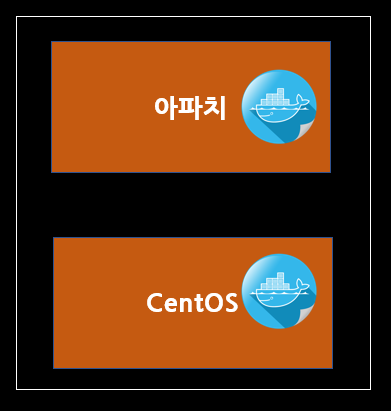
그럼 두번째 이미지를 공유하는 기능에 대해 알아볼게요.
도커는 도커레지스트리를 통해서 공유 할 수가 있어요.
도커의 공식 레지스트리는 Docker Hub가 있는데요,
우분투나 CentOS와 같은 리눅스 배보판의 기본 기능을
제공하고 있어요.
이런 이미지에 애플리케이션, 미들웨어 등을 겹쳐서
도커이미지를 만들어 가는 방식이에요.
공식이미지외에도 개인이 만든 이미지를 도커허브를 통해서
공유 할 수도 있어요.
마지막으로 세번째 컨테이너를 실행시키는 기능이에요.
1편에서 설명드린데로 도커는 컨테이너 단위로 작동을 해요.
이 컨테이너의 바탕이 되는 것이 도커이미지였어요.
이 이미지만 있으면 도커가 걸치된 환경에서는 어디에서라도
작동 시킬수가 있는 방식이죠.
보통 컨테이너 관리는 오케스트레이션 툴을 이용해요.
오케스트레이션툴은 분산환경에서 컨테이너를 실행하기 위한 필요한
기능들을 제공하고 있어요.
다음에는 도커를 무료로 이용 할 수 있는 툴을 소개해드릴게요.
#도커, #도커이미지, #docker, #도커기능
| 윈도우 엑셀파일, 맥북엑셀에서 안열릴때 (0) | 2019.12.12 |
|---|---|
| 초보자를 위한 파워포인트 초간단 단축키 (0) | 2019.12.11 |
| 도커가 뭔지 알아봤어요. (0) | 2019.12.04 |
| 도메인 웹호스팅 저렴하게 판매하는곳 (0) | 2019.12.01 |
| 에이프릴 랜툴세트(랜선테스터기 포함)랜선만들기 후기 (0) | 2019.11.29 |
안녕하세요.
이번에는 도커에 대해 알아보는 시간을 가져볼게요.
도커가 세상에 나온지 6년이 지난 지금,
IT관련 직업을 가지고 있지만,
도커를 제대로 알고 있는 사람도 있고
이름 정도만 알고 있는 사람도 있어요.
저 역식도 도커를 이름 정도만 알고 있는 사람 중에 하나에요.
그래서 도커에 대해 하나하나 알아보면서 여러분들과 내용을
공유해보려고 해요.
먼저 도커에 대한 기초적인 지식을 파악해 보려고요.
클라우드 시스템으로 인하여 누구나 가상머신을 쉽게 생성하고
관리 할 수 있는 시대가 되었어요.
그러다 보니 예전에는 인프라 인제니어나 오페레이터 업무 였던
구축이 지금은 애플리케이션 엔니지어들에게 요구되고 있어요.
클라우드가 등장하기 전에는 애플리케이션이 구동되는 실행환경,
즉 네트워크나 하드웨어는 인프라 엔지니어가 담당을 했어요.
애플리케이션 개발은 애플리케이션 엔지니어가 당담하는 방식이었죠.
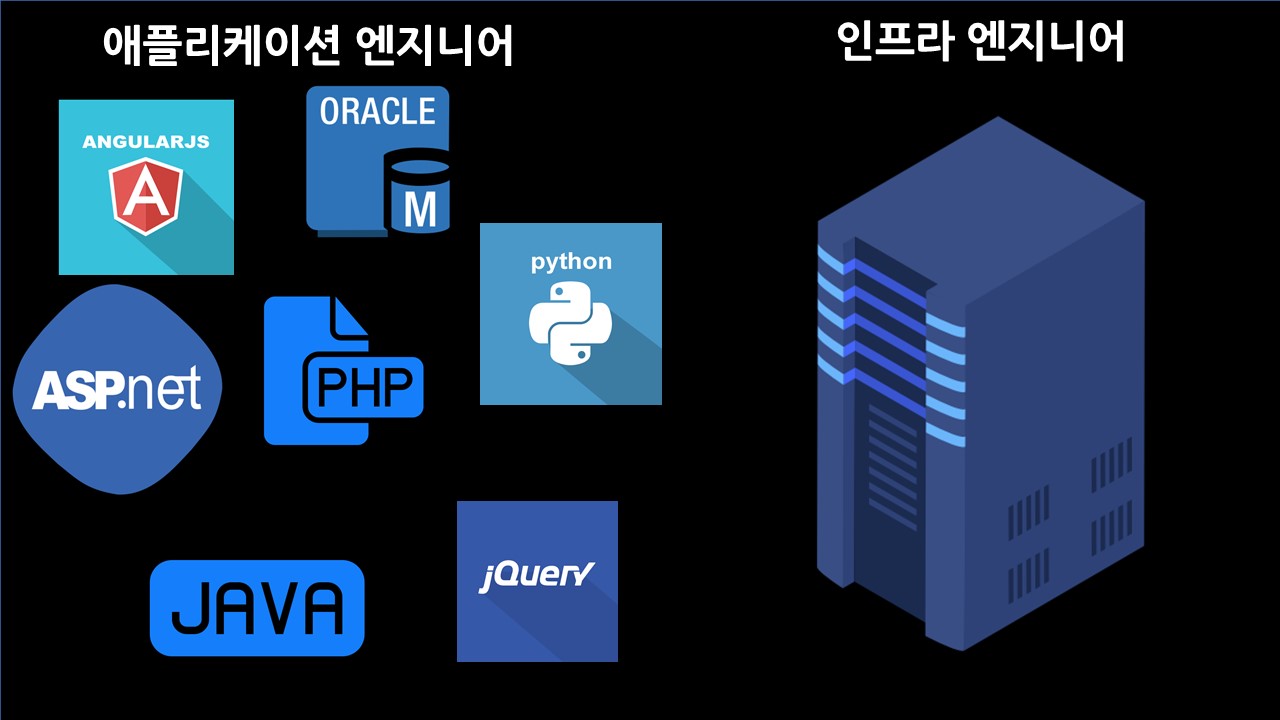
하지만 클루우드의 등장으로 많은 변화가 생기게 됩니다.
인프라 엔지니어가 수동으로 운영을 하던 환경을 자동화 툴을 사용하여
운영하면서 자연스럽게 인프라 엔지니어에게도 코딩능력을 요구하게 되었어요.
그럼 인프라 엔지니어에게만 업무가 늘어난 것이냐?
애플리케이션엔지니어에게도 애플리케이션의 배포나 테스트등 직접 할 수 있게 되다보니
운영체제나 네트워크 등과 같은 인프라 기술 혹은 지식이 요구되고 있어요.
그럼 클라우드 환경을 위한 도커, 그 도커를 이해하기 위해서는
먼저 컨테이너 기술에 대해서 알아야 해요.
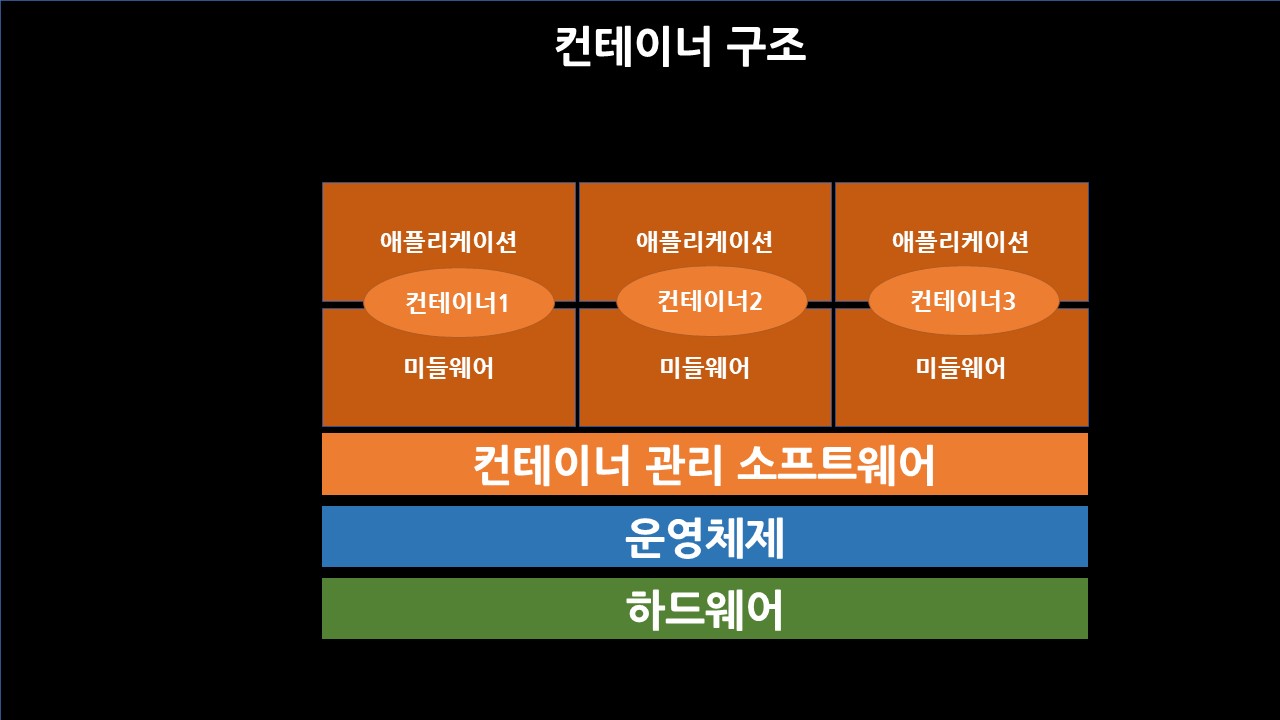
컨테이너라는 운영체제에 논리적으로 누누어서, 애플리케이션 작동을 위한
라이브러리나 애플리케이션등을 모아서 별도의 서버인것 처럼 작동 할 수 있게
해주는 기술이에요.
운영체제를 논리적으로 분산시킨 후 여러개의 컨테이너가 공유하는 것이 특징이죠.
컨테이너는 오버헤드가 적기 때문에 가볍고 빠르게 작동 해요.
기존의 방식은 하나의 운영체제에 여러 애플리케이션이 똑같은 자원을 사용하다보면
동일한 디렉토리, 동일한 IP 사용으로 인한 트러블 슈팅이 빈번하게 발생하고
때로는 과부하로 인한 문제들도 생기기도 했죠.
하지만 컨테이너는 운영체제, 디렉토리, IP를 따로 사용 하는 것 처럼 구동을 해요.
또한 애플리케이션 실행에 필요한 모듈을 컨테이너로 모을 수 있기 때문에
여러 개의 컨테이너를 조합해서 하나의 패클리케이션을 구축 하는 방식으로 많이 활용하죠.
그럼 도커가 어떻게 컨테이너에서 작동을 하는지 설명드릴게요.
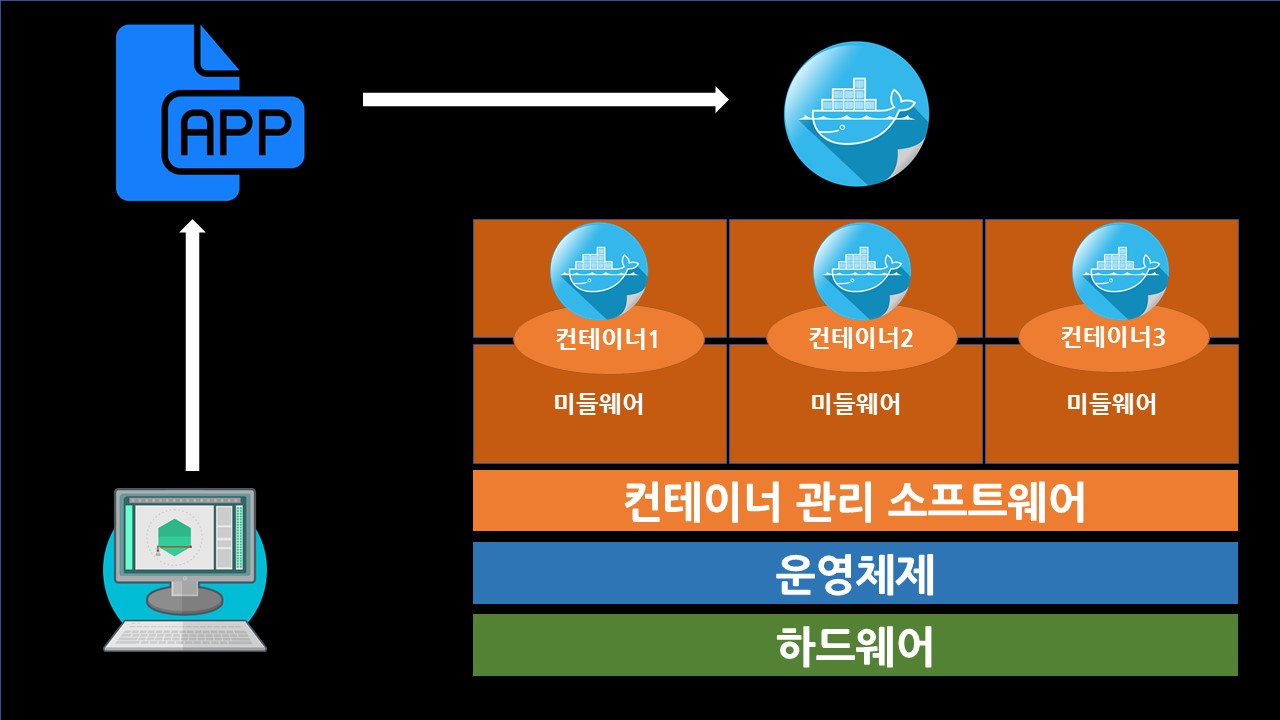
프로그램 가발자는 도커를 사용하여 애플리케이션 개발,실행에 필요한
모든 것이 담겨 있는 도커이미지를 작성해요.
생성된 도커이지미가 컨테이너의 바탕이 되는 방식이에요.
그리고 컨테이너를 실행 시킵니다.
이렇게 해서 개발부터 테스트, 실행 환경까지 모두 애플리케이션 엔지니어가
수행을 할 수가 있어요.
이렇게 사용하면 다른 환경에서도 작동하는 환경을 만들수가 있어요.
예를 들어 회사에서 개발 하다가 집에가서도 개발가능한.......(아.....이럼안되.....는ㄷ....)
다음에는 도커의 기능에 대해서 알아 보겠습니다.
#도커, #docker, #도커기능, #docker기초, #도커설명, #docker설명
| 초보자를 위한 파워포인트 초간단 단축키 (0) | 2019.12.11 |
|---|---|
| Docker? 도커? 기능 간단하게 3가지 (0) | 2019.12.06 |
| 도메인 웹호스팅 저렴하게 판매하는곳 (0) | 2019.12.01 |
| 에이프릴 랜툴세트(랜선테스터기 포함)랜선만들기 후기 (0) | 2019.11.29 |
| 정부지원 - 2019년 시범 스마트공장 구축사업 참여기업 모집 연장 공고 (0) | 2019.11.27 |
대한민국 도메인 점유율 공인 1위이며, 도메인, 호스팅, IDC, 기업솔루션, 웹사이트, 쇼핑몰 등 IT 비즈니스에 관한 인프라와 솔루션을 제공하고 있습니다.
웹을 넘어 클라우드로. 가비아
그룹웨어부터 멀티클라우드까지 하나의 클라우드 허브
www.gabia.com
보고와 결재는 우리나라 기업문화에서 빼놓을 수 없는 부분입니다. 회사마다 보고를 요구하는 문서의 종류도 다르고, 직급 체계나 결재 방식도 조금씩 차이가 있지만 한 가지는 공통적입니다. 팀원-파트장-팀장 순으로 차례차례 결재를 받아 의사결정을 진행하고, 그 문서를 보존한다는 점입니다.
때문에 실적보고, 주간보고, 휴가보고, 지출보고 등 업무 진행이나 의사결정에 필요한 다양한 보고서를 올리고 거기에 사인이나 도장, 전자서명 등으로 결재를 받는 것이 대부분 기업들이 업무를 하는 방식일 것입니다. 이것은 의사결정을 메일로 진행하는 외국 기업들과 가장 다른 점입니다.
우리나라에서는 업무 전산화가 이루어지기 전부터 종이문서로 보고하고 결재하는 문화가 정착해있었습니다. 의사결정구조가 상하 수직적이고, 중앙집권적이며, 위에서 책임지는 형태로 되어 있어 의사결정에는 반드시 보고와 허락이 필요했던 것이죠. 또한 의사결정으로 인해 영향을 받는 부서의 합의와 협조, 참조도 중요한 절차로써 결재 문서 양식에 포함되었습니다.
이런 절차는 인터넷이 보편화되고 업무 전산화가 이루어진 이후에도 관습으로 남아 ‘전자결재’를 탄생시키기에 이릅니다. 그래서 이전에는 결재판을 들고 팀장님 책상 앞을 서성거리거나 결재받은 서류를 차곡차곡 쌓아 보관하는 것이 일상적인 풍경이었다면, 이제는 스마트폰에서 알림을 받고 앱을 통해 결재하는 것이 일반적인 일이 되었습니다.
전자결재는 기존의 수직적인 의사결정 구조를 따르기는 했지만, 보고 문화를 크게 바꾸어놓았습니다. 얼굴을 맞대고 실물 도장이나 사인을 받을 필요가 없어지고, 결재자가 부재중일 때도 문제가 없게 되었습니다. 또한 문서 양식이 통일되고 문서 관리가 중앙화되면서 종이문서를 작성하고 관리하는 것에 대한 비효율과 보안 우려도 해소되었습니다. 전자 문서함에 종류별로 문서가 쌓이기 때문에 다시 찾아보는 것이 쉽고, 분실 걱정도 사라졌습니다.
전자결재를 도입하며 일어난 무엇보다 좋은 변화는 의사결정의 속도가 빨라졌다는 점입니다. 전자결재를 사용하기 시작한 기업들은 기존에 결재가 완료되기까지 3주가 걸렸다면 지금은 하루, 빠르면 한 시간 안에 결재가 완료된다고 이야기합니다. 그만큼 전자결재를 통해 불필요한 커뮤니케이션 비용과 비효율을 개선하고 경쟁력과 생산성을 높일 수 있게 되었습니다.
전자결재를 통한 커뮤니케이션 문화가 생산성 향상으로 이어지기 위해서는 기업의 노력도 필요합니다. 예를 들면 결재 단계를 축소하거나 요구하는 보고의 종류를 더 간소화하여 의사결정에 필요한 시간과 비용을 줄일 수 있습니다.
결재는 우리나라의 독특한 기업문화지만 문서에 서명하는 순간 의사결정에 대해 다시 한번 숙고하게 되고, 그에 대한 책임 소재를 분명히 한다는 점에서 메일로만 업무를 하는 것보다 좋은 점이 분명 있습니다. 모두 전자결재를 잘 활용해 업무에 필요한 커뮤니케이션과 의사결정이 효율적으로 이루어지기를 바랍니다.
포스팅은 제휴마케팅이 포함된 광고로 일정 커미션을 지급 받을 수 있습니다.
| Docker? 도커? 기능 간단하게 3가지 (0) | 2019.12.06 |
|---|---|
| 도커가 뭔지 알아봤어요. (0) | 2019.12.04 |
| 에이프릴 랜툴세트(랜선테스터기 포함)랜선만들기 후기 (0) | 2019.11.29 |
| 정부지원 - 2019년 시범 스마트공장 구축사업 참여기업 모집 연장 공고 (0) | 2019.11.27 |
| 2019년 시범 스마트공장 구축사업 추가모집 공고 (0) | 2019.11.21 |
안녕하세요. 회사에서 생산관련 시스템을 구축 하면서
오랜만에 랜선을 만들게 되었어요.
하지만 랜선을 만들기 위한 도구가 전혀 없어서
이번에 세트로 된 도구를 검색하다가 에이프릴 랜툴 세트를
발견 했어요.
에이프릴 랜툴 세트 rj45 커넥터 랜툴기 랜 테스터기 랜케이블
COUPANG
www.coupang.com
가격도 저렴하고 구성도 마음에 들더라구요.
전 B타입으로 구매했어요.
구성은 UTP CAT5 커넥터 20개
RJ45 보호 커버부트 20개
랜케이블 피복제거 툴
I형 커플러(랜선 연장시 사용)
랜선정리 케이블 타이 30~40개
랜테스터기
건전지9V
랜툴
이렇게 들어있어요. 딱 제가 필요한 구성은 다 있더라구요.
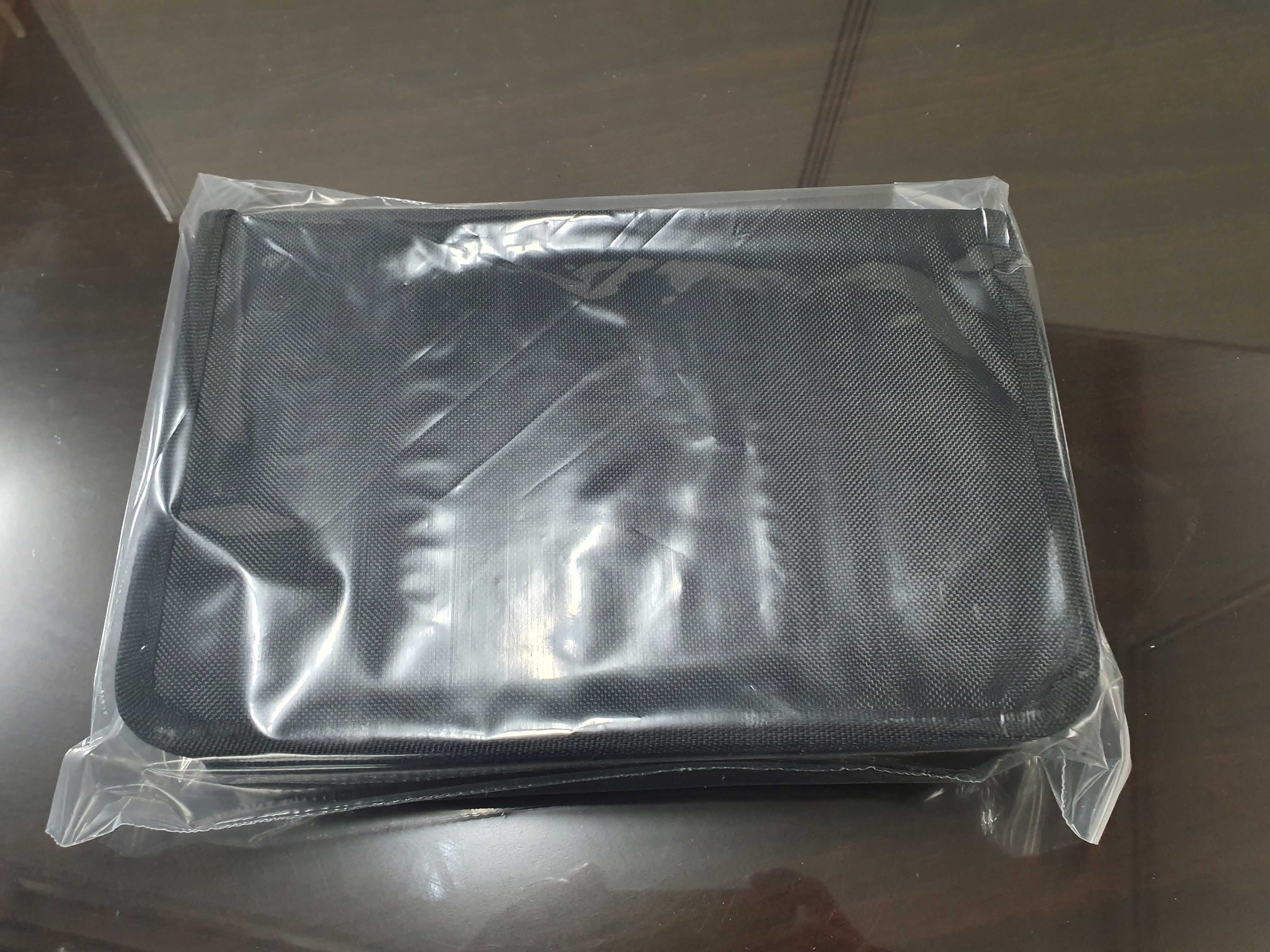
가방에 구성품이 있어요.
이 가방을 열어보면 구성품이 나란히 있어요.
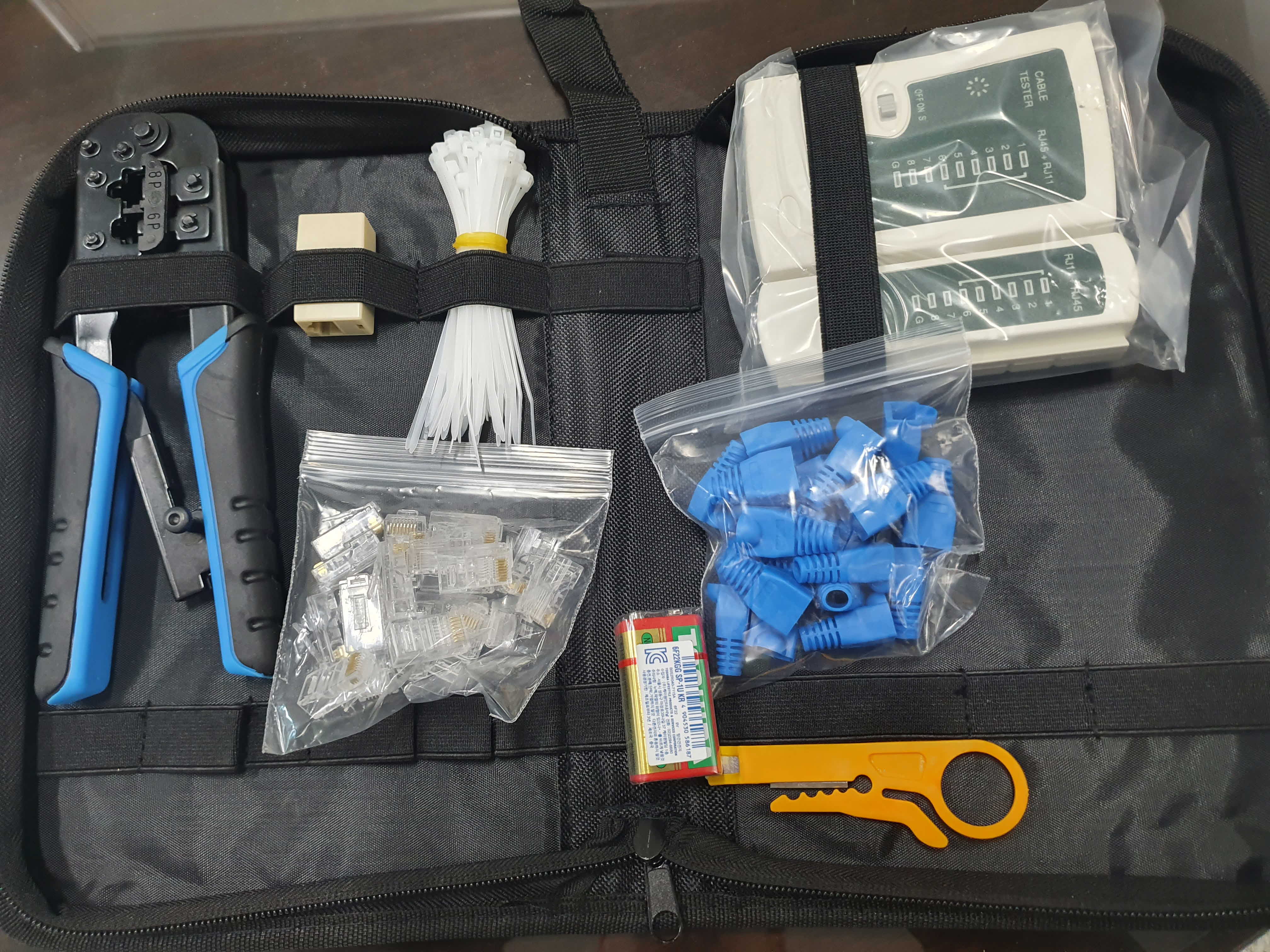
구성품을 확인해보면 빠짐없이 왔어요.
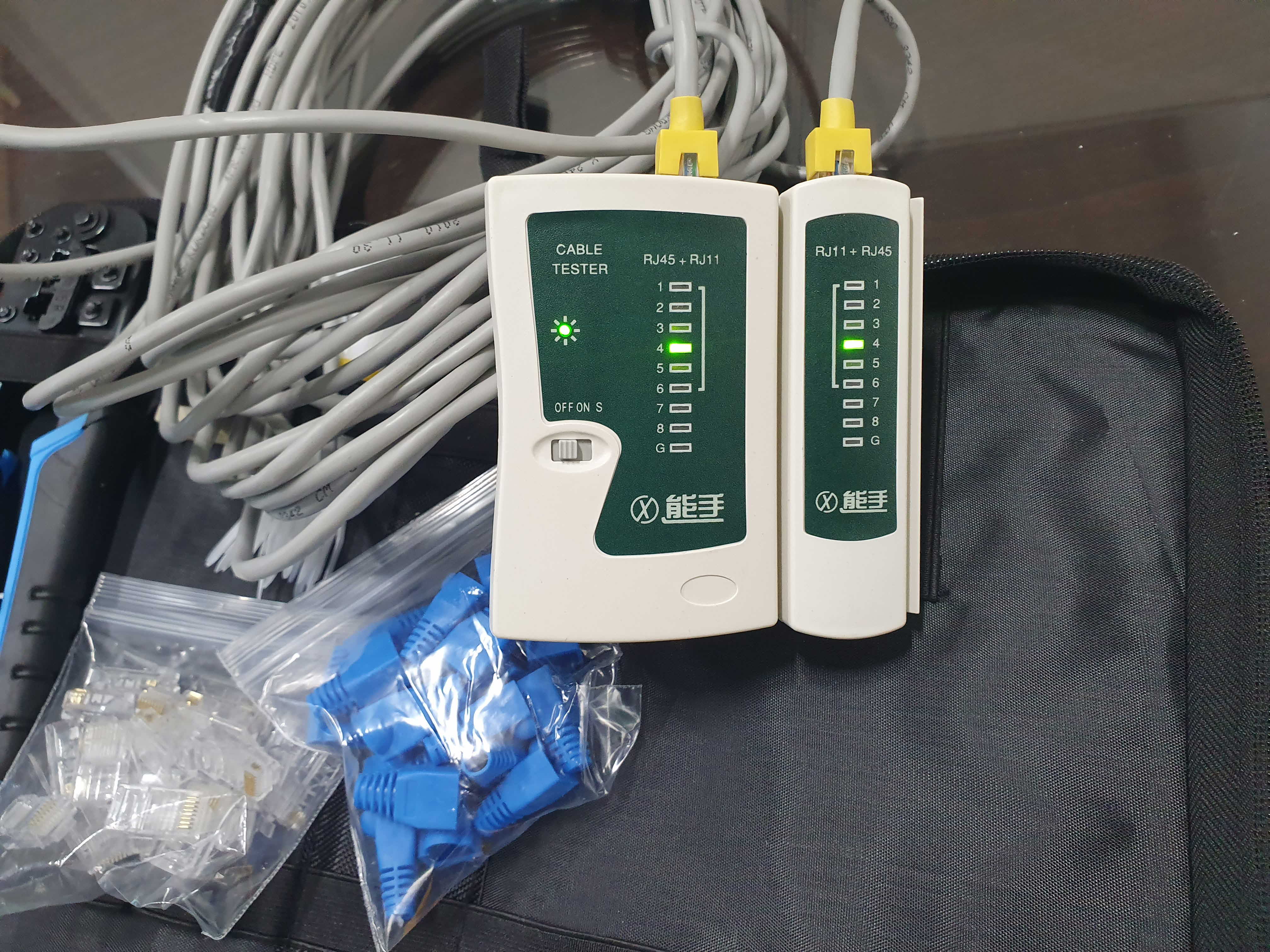
랜선을 하나 랜선테스터기에 연결해보니
랜선테스터기도 문제 없이 작동하네요.
이상으로 에이프릴 랜툴세트 후기를 마치며 랜선 만들로 가보겠습니다~
참고로 랜선 만들때 선 배열이에요.
줄주황 주황 줄녹색 파랑 줄파랑 녹색 줄갈색 갈색
#에이프릴랜툴세트, #에이프릴, #랜툴, #랜테스터기, #랜선테스터기, #lan테스터기, #lan선테스터기, #랜테스트, #랜점거, #랜선만들기, #랜선배열
| 도커가 뭔지 알아봤어요. (0) | 2019.12.04 |
|---|---|
| 도메인 웹호스팅 저렴하게 판매하는곳 (0) | 2019.12.01 |
| 정부지원 - 2019년 시범 스마트공장 구축사업 참여기업 모집 연장 공고 (0) | 2019.11.27 |
| 2019년 시범 스마트공장 구축사업 추가모집 공고 (0) | 2019.11.21 |
| 올해의 APP(앱) (0) | 2019.11.17 |